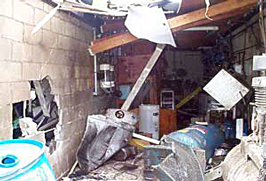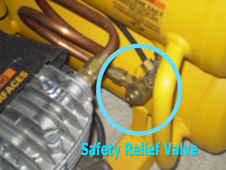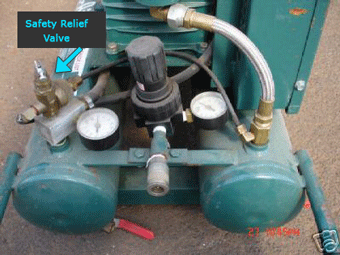Portable Air Compressors
An air compressor is the central power source for pneumatic tools. Air compressors may be portable or stationary and powered by either electricity or gasoline in most cases. This section will focus on portable compressors only. Air compressors that exceed 1.5 cubic feet and have safety valves set to open above 150 psi require special permits to operate. Air tanks subject to a maximum allowable working pressure not exceeding 150 psi and having a volume of 25 cubic feet or less shall be inspected by CalOSHA when placed into service. An indefinite permit is then issued for that compressor.
Regardless of which type or size you might be using to power your pneumatic tools, there are inherent risks associated with each type. Compressor hazards include:
-
excessive pressure
-
flying objects
-
mechanical failures
-
fires
-
explosions
-
toxic gas (carbon monoxide)
-
flammable liquid
-
hot surfaces
-
moving parts
-
dangerous noise levels

Which compressor should be used?
When choosing an air compressor, look for one that has been certified by the American Society of Mechanical Engineers (ASME). The ASME certification will be permanently stamped into the tank indicating that it meets all applicable safety standards. ASME has published a safety standard specific to air compressors: The Safety Standard for Air Compressor Systems (B19.1). This standard addresses the construction, installation, operation and maintenance of air compression equipment.
Safety Relief Valves
A safety relief valve or pressure relief valve is required to be installed on all air compressors. These valves allow air to automatically escape if pressure inside the tank exceeds a pre-set level. Safety valves should be set to open at not more than the allowable working pressure of the tank. These valves also have an attached pull ring to allow the user to check the valve to make sure it is not clogged or otherwise inoperable. OSHA standards require compressor safety valves to be activated at least weekly. Safety relief valves should never be altered, modified or defeated and repairs and adjustments should be made by qualified personnel only.
To test the safety relief valve
-
Grasp the wire ring and pull outward to release air pressure.
-
Do this a few times to ensure the plunger moves in and out freely.
-
Replace the valve if it fails to move freely and release air.
-
Replace the valve if it fails to re-seat itself and stop the flow of air when released.
-
If problems are found, the compressor should not be operated until the necessary repairs have been made.
Drain Valves
Air compressor tanks should be fitted with a drain valve that is located at or near the bottom. Tanks will accumulate substantial amounts of water and other contaminants if not drained frequently. This can lead to tank deterioration and eventually lead to tank failure. For this reason, tanks must be drained on a regular basis to prevent damage. Some tanks have automatic drain systems and are exempt from this provision. After draining the tank, leave the valve open to allow any residual moisture to evaporate.
Startup Procedures
Several items should be inspected before turning a compressor on and pressurizing the tank. Failure to read, understand and follow the manufacturer’s operating instructions could lead to serious injury. Be sure to put on your safety glasses and then cover the items listed below.
Compressor should be on level ground and secured against movement.
-
Check the oil level by looking at the sight gauge or dip stick.
-
Check air filters for cleanliness.
-
Ensure all required guards are in place and properly secured.
-
Be sure the compressor is in the OFF position before connecting to the power supply.
-
If powered by gasoline, fill the tank only when it is cool to the touch.
-
Close the tank drain valve.
-
Turn switch to the ON position to start compressor.
-
Watch the pressure gauge to see that the tank pressure reaches normal level and automatically turns off—if compressor does not automatically turn off at the maximum pressure, flip the switch to the OFF position.
-
With tank at normal operating pressure, adjust the air control knob to the preferred PSI operating level for the tool being used—never exceed the recommended operating pressure for a tool.
-
When finished using the compressor, remove the tool, turn the switch to the OFF position, unplug from the power supply and drain the air and accumulated moisture through the drain valve.
Continue to Next Chapter



